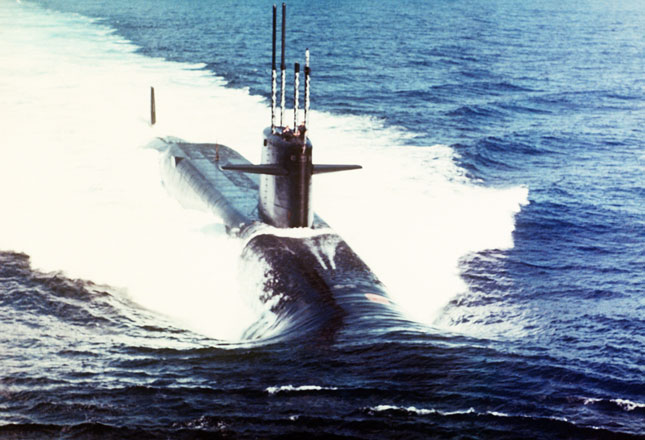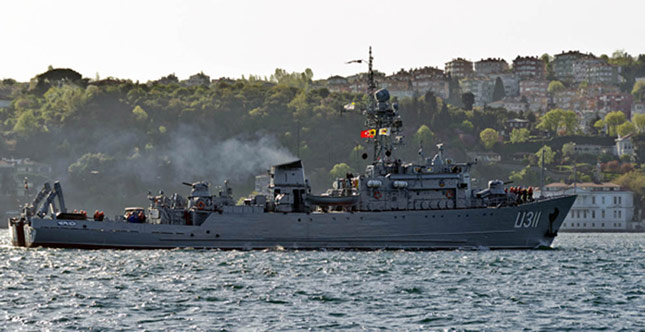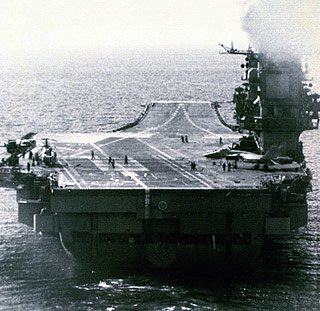Cold War Rewind (Have Phantom Submarines Come Back to Haunt Sweden?)
A drama worthy of the worst periods of tension during the post-WW2 standoff between the Soviet Union and the West has been unfolding in the Baltic, for Sweden has revealed it is hunting a mystery vessel.
It really is an extraordinary case of Cold War rewind, plunging the Swedes right back into a nightmare they hoped to have left far behind. During the 1980s the issue of foreign submarines allegedly making forays into its waters became intensely political for Sweden. It even stoked paranoia of forces within the country itself favouring one side or the other in the East-West confrontation.
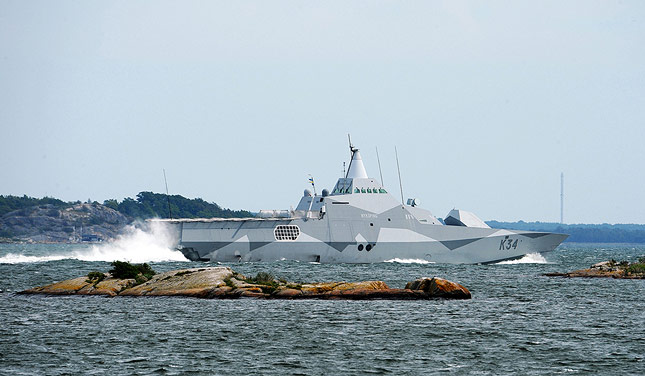
HSwMS Nykoping, a Visby Class corvette of the Royal Swedish Navy, a type of Anti-Submarine Warfare (ASW) capable vessel said to have been searching for the mystery submarine. Nykoping is pictured here sailing in shallow coastal waters off Karlskrona. Photo: Guy Toremans.
Despite Swedish military forces stopping just short of an all-out public accusation that this new intruder is a Russian, nobody would be surprised if it is a Baltic Fleet submarine. The Kremlin has already sent its aircraft to spy on Western maritime exercises in the Baltic and surface warships to shadow them closely, so why not submarines to keep an eye on the Swedes or NATO?
Swedish officials have admitted they are looking for something in a massive “intelligence operation” but are denying a submarine hunt as such. They do say that a radio message in Russian was picked up on a frequency normally used for submarine distress calls.
At the time of writing the Swedes claim to have detected evidence of submarine activity three times – and the Swedish Defence Ministry has published images of a small, dark shape moving on the surface close inshore. There are even supposed sightings of dark figures wading ashore.

An image released by the Swedish military, which was taken by an amateur photographer. It supposedly shows a mystery craft making a wake close inshore to Sweden. It has been speculated this may be a surfaced mini submarine. Photo: Swedish Defence Ministry.
Moscow has denied there is anything unusual going on, besides the usual operating patterns of Russian Navy submarines, and there are no emergencies to report. If it is a conventional Russian submarine, then it is likely to be an elderly Kilo Class boat. Even in the Cold War the Baltic Fleet did not get receive front line submarine types – the top models were, and remain, reserved for the Northern and Pacific fleets.
A new generation of diesel boats is, though, being built in St. Petersburg at the top end of the Baltic. Could one of these be on sea trials and have gotten into trouble? Or maybe it was sent to try out its stealth qualities for real?
An alternative explanation is that a mini submarine used for shallow water insertion of Special Forces and offshore surveillance is the guilty party and has become stranded somehow. There have been reports of a Russian merchant vessel, rumoured to be the craft’s mother ship, loitering just outside Swedish territorial waters and cruising in random patterns. Three warships from the Royal Netherlands Navy were reportedly shadowing this vessel in international waters.
The mystery undersea craft will not be a nuclear-powered or armed submarine. The Baltic is too shallow and tricky navigation-wise for SSN or SSBN operations. The nuclear-armed diesel-electric Golf Class boats of the Cold War based at Kronstadt are long gone.
The dilemma of what to do was, and remains, extremely tricky for Sweden. It was neutral during the Cold War and these days, while it works very closely with NATO naval forces, is still not part of the alliance despite having a newly aggressive Russia glowering at it from the other side of the Baltic.
We have already seen Russian troops annexing the Crimea, waging a so-called covert war in eastern Ukraine and even airliners being shot down, so why not mystery submarines in Swedish waters? There is an eerie parallel here with the most notorious such incident, the so-called ‘Whiskey on the Rocks’ episode, as related in ‘Hunter Killers’. In late October 1981, an old Whiskey Class submarine of the Soviet Navy ran aground just off Karlskrona Naval Base. When some local fishermen reported they had discovered a Russian submarine perched on some rocks the Swedish military thought they were drunk, until, that is, they sent somebody out to take a look and found out it was true.
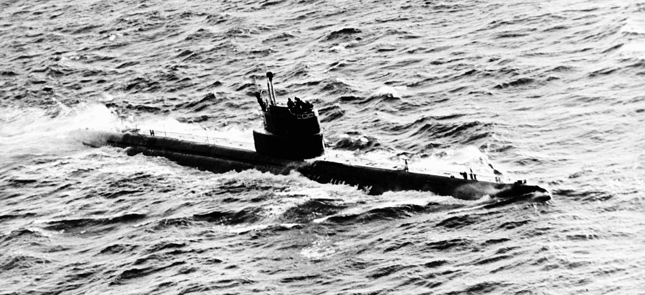
A Whiskey Class diesel-electric submarine of the Soviet Navy cruises on the surface during the Cold War. In 1981 one such vessel became stranded off a Swedish naval base, in the notorious ‘Whiskey on the Rocks’ episode. Photo: US DoD.
Throughout the 1980s the Swedes frequently detected what they suspected were foreign submarines in their territorial waters. They sent out helicopters and surface vessels to hunt them down, dropping depth charges in some instances during pursuits that lasted for days.
When it comes to the “credible source” the Swedes say they are relying on to indicate submarine activity, this must mean a sonar contact of some kind, whether seabed sensors, a maritime patrol aircraft, surface craft or even one of their own submarines.
The Swedes will be very wary of going too hard on what exactly it is they believe they have detected and also of saying who exactly is down there. For it is not easy to gain a positive contact of a submarine in the Baltic. It could well be a phantom that Sweden is pursuing or even ‘a biologic’ (as it was termed in the Hollywood Cold War submarine drama ‘Hunter for Red October’). In other words, a marine creature rather than steel boat. In the Cold War days, the Swedes may well have chased porpoises or even flatulent herring rather than submarines.
If it was submarines in the old days, they could have been NATO diesel-electric submarines rather than Russian boats. Those same uncertainties apply today, though the Royal Navy – which ran numerous covert missions using submarines into the Baltic during the Cold War – is no longer in the business since going fully nuclear-powered, which also applies to the US Navy.
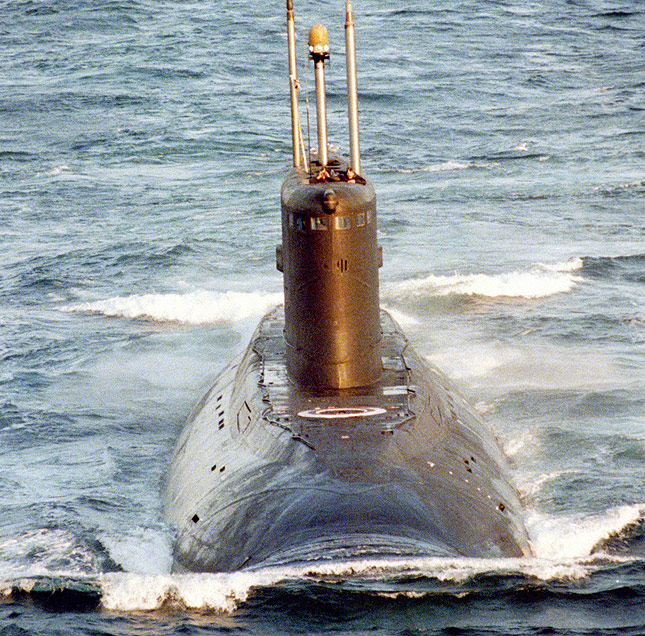
The Russian Navy continues to operate Kilo Class diesel-electric patrol submarines in the Baltic. Photo: US Department of Defence.
Would the Germans or Norwegians send their extremely capable conventional submarines on covert missions into Swedish waters? Not likely, as they work very closely with the Royal Swedish Navy already and surely know all they need to about the Swedes? Russian suggestions that it is a Dutch diesel submarine that was exercising off the Swedish coast recently look very much like Moscow deploying its usual obfuscation. The Swedes say they have intercepted Russian language communications and another transmission (this time encrypted) sent to Kaliningrad, the Russian enclave in the southern Baltic that is host to a major naval base. Additionally, submarine water space management as operated by NATO means that any Western submarine would only be dived in clearly delineated waters, to safeguard against accidents and also to enable unauthorised intruders to be identified and countered. NATO member Poland, the other Baltic diesel submarine operator, is unlikely to risk one of its ancient diesels. Therefore, if the contact the Swedes have made is a real submarine rather than a phantom, it is almost certain to be Russian, returning to the old underwater espionage game of the Cold War era.
‘Hunter Killers’ was recently published in paperback by Orion Books and is available from Amazon or direct from Orion. Iain Ballantyne is also the editor of the UK-based global naval affairs monthly magazine WARSHIPS International Fleet Review. www.warshipsifr.com
 Two brothers at the heart of arguably the greatest ever betrayal of their nation’s defence secrets, died in prison within weeks of each other during the summer of 2014.
Two brothers at the heart of arguably the greatest ever betrayal of their nation’s defence secrets, died in prison within weeks of each other during the summer of 2014.
